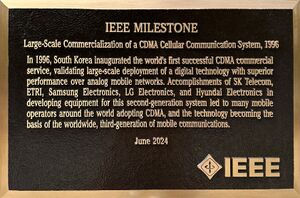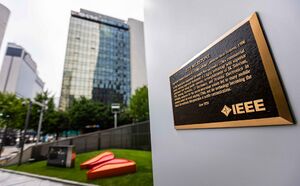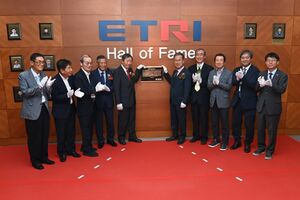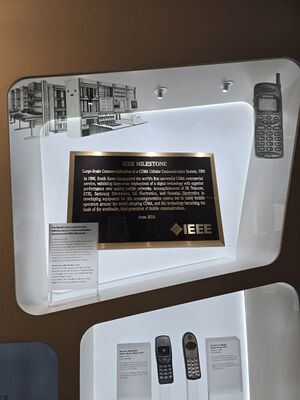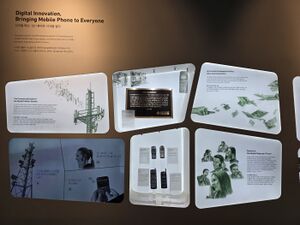Milestones:Large-Scale Commercialization of a CDMA Cellular Communication System, 1996




Title
Large-Scale Commercialization of a CDMA Cellular Communication System, 1996
Citation
In 1996, South Korea inaugurated the world’s first successful CDMA commercial service, validating large-scale deployment of a digital technology with superior performance over analog mobile networks. Accomplishments of SK Telecom, ETRI, Samsung Electronics, LG Electronics, and Hyundai Electronics in developing equipment for this second-generation system led to many mobile operators around the world adopting CDMA, and the technology becoming the basis of the worldwide, third-generation of mobile communications.
Street address(es) and GPS coordinates of the Milestone Plaque Sites
- Site 1 (SK Telecom #1): SKT Tower, 65 Eulji-ro, Jung-gu, Seoul, South Korea (37.5664480, 126.9851140)
- Site 2 (SK Telecom #2): 6 Hwangsaeul-ro 258beon-gil, Bundang-gu, Seongnam-si, Gyeonggi-do, South Korea (37.3805736,127.1157288)
- Site 3 (ETRI #1): Electronics and Telecommunications Research Institute (ETRI), Research Building 7, 218 Gajeong-ro, Yuseong-gu, Daejeon, South Korea
- Site 4 (ETRI #2): (location is TBD)
- Site 5 (Samsung Electronics): Samsung Innovation Museum, Samsung Electronics, 129 Samsung-ro, Yeongtong-gu, Suwon-si, Gyeonggi-do, South Korea (37.2579935, 127.055543)
- Site 6 (LG Electronics): LG Magok Science Park, Magok Jungang 10-ro, Gangseo-gu, Seoul, South Korea (not yet installed)
Details of the physical location of the plaque
- Site 1 (SK Telecom #1): On the south-facing side of the pillar located in the southwest corner of the SKT Tower, adjoining the building entryway
- Site 2 (SK Telecom #2): On the left pillar of the main entrance of the building
- Site 3 (ETRI #1): In the Hall of Fame on the L Floor of Research Building 7; visitors to ETRI Building 7 can view the plaque freely
- Site 4 (ETRI #2): (location is TBD)
- Site 5 (Samsung Electronics): Samsung Innovation Museum Hall 2, Mobile Zone in "World's First CDMA Commercialization" section
- Site 6 (LG Electronics): (specifics are TBD)
How the plaque site is protected/secured
- Site 1 (SK Telecom #1): SKT Tower security; 24/7 access
- Site 2 (SK Telecom #2): SKT security; 24/7 access
- Site 3 (ETRI #1): Building 7 security; 24/7 access
- Site 4 (ETRI #2): (location is TBD)
- Site 5 (Samsung Electronics): Campus security; accessible on weekdays 13:00-14:00 by pre-reservation only, Saturday 10:00~17:00
- Site 6 (LG Electronics): (specifics are TBD)
Historical significance of the work
Abstract of Historical Significance
Rising from the ruins of the Korean War in 1950-1953, South Korean government, research institutes, service providers, and phone manufacturers developed CDMA commercial cellular systems and launched commercial service on 3 January 1996. At the end of 1996, CDMA subscribers reached 0.9 million. South Korea’s fast adoption of CDMA led to significant growth in the mobile technology industry domestically and worldwide and became a momentum to the subsequent development of next-generation mobile communication systems.
Limitation of the First Generation Mobile Networks
After the launch of mobile phones in 1988, the number of analog cell phone subscribers approximately doubled every year, reaching 0.96 million in 1994 and 1.64 million in 1995. Korea Mobile Telecom (KMT), a predecessor of SK Telecom and the only mobile network operator in South Korea at the time, was providing analog cellular network service using 15MHz, its maximum capacity was only up to 1.5 million subscribers. As the number of subscribers continues to increase, the capacity saturation resulted in increasing subscriber complaints including voice quality degradation.
South Korea’s Audacious Decision on CDMA
As the mobile communication service technology moved from the first generation analog systems to the second generation digital systems, the preferred technology was TDMA at the time worldwide. CDMA, proposed by Qualcomm in 1988, was still a novel concept, hotly disputed and challenged on its commercial feasibility by the world’s major mobile industries. CDMA used a more complex transmission that operated across a broad range of the radio spectrum and held promise for more efficient use of the radio spectrum and more carrying capacity. However, when the government was considering the CDMA technology for its mobile network in 1993, the success was far from certain as it had never been implemented commercially before [1]. The government declared CDMA as the Korean Digital Cellular Standard in 1993 with a firm belief that only the ground-breaking technology based on sound engineering practice would allow her to gain a foothold within the competitive world market. A national project was launched to develop and commercialize CDMA, with engineers at ETRI, Electronics and Telecommunications Research Institute, which was the first to be involved. Also, in 1993, the government appointed Seo Jung-Uck to oversee the project, (who later joined SK Telecom as a president). Samsung Electronics and LG Electronics started sending engineers to ETRI for joint research. By 1994, ETRI, together with Samsung Electronics and LG Electronics engineers, pieced together a working system and successfully tested it at the testbed in Jangan-dong, Seoul.
Pioneering Efforts to Develop Commercial Equipment
Since Qualcomm’s CDMA technology had never been trialed for commercialization, it required technical verification and development before commercialization. In June 1993, KMT (predecessor of SK Telecom), launched the Mobile Telecommunications Technology Development Project Management Office (PMO) and began the development of the commercial CDMA system based on then-current research. ETRI also came up with a trial-purpose prototype KCS (Korean Cellular System) in May 1994 and successfully made the first CDMA voice call. Their efforts did not just stop there - they finally delivered a domestically developed, commercial-purpose prototype of CMS (CDMA Mobile System) for the first time in September 1994, and began field tests in Seoul the next year. In June 1995, at the 1995 Information and Telecommunication Exhibition at COEX, the CDMA technology was unveiled to the public for the first time through a mobile phone demonstration. To be specific, the very first mobile phone demonstration was carried out for the press corps in a shuttle bus on their way to COEX, and it raised hopes and expectations for CDMA implementation.
Dedicated Preparations for Commercialization
After finishing the commercial verification, the preparation to offer CDMA services began in June 1995. Since CDMA was technically very different from the analog system, design criteria including cell planning and capacity had to be established based on testbed results, and this became the basis for the network deployment. Not only that, BTS (base transceiver station) optimization and interworking with the analog network were carried out to secure service quality and reliability. KMT formed a CDMA service trial group that included about 200 employees and continued commercializing efforts including carrying round-the-clock quality tests. In October 1995, Incheon and Bucheon were chosen to become the first cities to launch the commercial CDMA service. 28 base stations across the cities were installed, began to operate, and were optimized over just about 3 months. Also, the frequencies had been reallocated to 112 base stations in Seoul and the capital area for operation in just 4 months, which made it possible to offer the service in broader areas starting from April 1994 [3].
World-First Successful CDMA Commercial Service
The pioneering and challenging spirit of KMT, ETRI, and vendors such as Samsung Electronics and LG Electronics have led South Korea to realize the goal of launching the first commercialized CDMA service in 1996 [4][18]. Exactly on January 1, 1996, KMT began to operate 28 CDMA base stations across Incheon and Bucheon to offer the world’s first CDMA mobile phone service. On January 3, it accepted the first subscriber and initiated the commercial service, just one month after the initiation of a very small and unsuccessful CDMA deployment in Hong Kong. The coverage spread to Seoul and the capital area in April [5], Ulsan in July, Daegu and Gyeongbuk area in August, and Busan, Gyeongnam, Gwangju and Jeonnam areas in September. At the end of 1996, CDMA coverage had reached over 79% of the total population (about 37 million people) with about 0.9 million subscribers.
Continued Service Expansion
In the first quarter of 1997, the number of CDMA subscribers exceeded 1 million, and the operation of the CDMA system had been working successfully to reach close to a predicted limit as in Fig. 1. The service was expanding steadily for wider coverage and increasing capacity.
The success of South Korea's CDMA commercialization proved that CDMA technology could accommodate more subscribers, leading to an increase in the global adoption of CDMA technology and a corresponding rapid increase in subscribers as in Fig. 2.
More Than 10x Capacity
CDMA was theoretically expected to have 10 times more call capacity than the analog communication system[14], but this had never been verified before. On May 31, 1995, in the final commercial equipment verification process in South Korea, the CDMA base station's call capacity verification test was conducted, and the call capacity of the analog 10 times was confirmed [15]. AMPS had a very limited capacity because a single cellular call occupied one channel. CDMA achieved a capacity gain of about 10 times more than that of the previous analog system, the capacity advantage which is based on the signal spreading technology with the unique code and variable rate coding of voice data, the suppression of the transmission of silence.
Significant Improvement of Call Quality
Before the implementation of CDMA, KMT/ SK Telecom, had been receiving many complaints from users about call dropping, failed call attempts, and poor voice quality for AMPS analog service. Therefore, one of the important features of CDMA had to be high capacity and good voice quality. AMPS had a very limited capacity which occupied a single channel when making a cellular call. Poor voice quality of AMPS came from analog signal processing and hard handover. But in CDMA, digital signal processing and soft handover were employed. Furthermore, the component technology, power control, suppression of background noise, etc. led by CDMA improved customer satisfaction with seamless voice quality. After that, SK Telecom developed and commercialized EVRC (Enhanced Variable Rate Coder) technology in November 1997 for the first time in the world which successfully further upgraded voice call quality[20].
Impact on Global Digital Mobile Network Evolution
Since the successful commercialization of CDMA in 1996 in South Korea, the CDMA became a favorable air interface in digital mobile networks in the subsequent development of the next generations of mobile communication. SK Telecom launched cdma2000-1x for the first IMT-2000 service as the 3rd generation digital mobile network in the world in October 2000. As a result, the number of subscribers exceeded 32 million in 2004 [6][7]. The 3rd Generation Partnership Project (3GPP), which originated from the GSM technology based on TDMA, also accepted CDMA as its 3rd generation digital mobile network standard (Wideband CDMA).
Global ICT Leadership and South Korea
The world-first commercialization of CDMA was the turning point for South Korea in the technology innovation field. Based on valuable experiences in developing necessary components of CDMA commercial equipment and services, the country became one of the world's leaders in ICT [1][2]. SK Telecom has led the digital mobile commercialization from cdma2000 to 5G by launching the world's first services of cdma2000, HSPA, LTE-Advanced, and 5G [8]. The success has become a great momentum for domestic manufacturers to jump right into the digital mobile market, positioning their status as leading manufacturers of CDMA equipment. Mobile phones became one of the most prominent export products of South Korea. Samsung Electronics, the world's largest manufacturer of memory chips, became the leading handset maker. LG Electronics achieved the largest CDMA market share (21.3 million, 21.6%) since 2003. In 2006, LG Electronics sold 38.5 million CDMA mobile phone handsets worldwide accounting for 22.3% of the world CDMA market and Samsung Electronics ranked 3rd globally (25.6 million, 14.9%). Samsung Electronics became the world-leading smartphone manufacturer and kept its top spot in the global smartphone market in 2022 by accounting for 22% of worldwide shipments [16]. LG is currently rapidly expanding its presence in the automotive telematics market.
Obstacles that needed to be overcome
New Technology Never Commercialized Before
CDMA was a new system proposed by Qualcomm in 1988 and was considered to be a maverick that many experts doubted feasibility for commercial applications. The theoretical background of the CDMA cellular system looked sound, but many experts pointed out several difficult implementation issues like power control and overall complexity. Furthermore, because Qualcomm's CDMA technology was limited to the air interface technology, the commercialization of CDMA required further development of switchboards, network technologies, and components to be used for this novel mobile phone service. Also, the domestic industry did not have prior experience in developing wireless network systems; neither digital nor analog. Hence, the obstacles to commercially developing the CDMA technology to be overcome were enormous, in terms of technical innovation (as listed discussed below) and engineering expertise.
Soft H/O and RF Verification
The existing RF technology required further development, especially in terms of the soft handoff technology, which impacts call quality. While it was considered an excellent technology theoretically, however, it was not operable as expected in the field due to constantly changing signals. Specifically, the topographical characteristics of Seoul – mountainous terrain, dense population, and a 1km-wide river penetrating the city – were part of the biggest failure factors. Due to these characteristics, there were frequent handoff failures near the bridges and riversides as the signals from across the river flow along the surface of the river and try abnormal handoffs. Here, the only way to solve the problem was optimization via field inspections. Employees from almost all departments of companies involved in this grand project went out to participate in the field measurement for call quality improvement. Also, there had been continued uplink quality degradation during the verification process before the commercialization. To find out the root cause, there were a series of in-depth tests on hardware modules and it turned out the IMD (Intermodulation Distortion) had caused the problem. After that, the transmission filter modules were replaced to improve the quality. More issues were identified and relevant software features were improved almost every day, and brought the quality to a stable level.
Interworking with Analog Networks
To minimize subscriber inconveniences, it was decided that the commercial CDMA service should use analog-digital dual-mode devices. In September 1995, the network interworking between AMPS and CDMA was developed and realized in the ETRI laboratory. However, in the field, the environment such as topography, buildings, and radio interference changed, and the implementation continued to fail. Analog services were operating close to saturation, and interworking with the CDMA network, which had not been verified for stability, was risky. In addition, there were no data to refer to, as the AMPS and CDMA network interworking had never been tried before. It was a great effort put into overcoming the obstacle of interworking with the analog network stably and was successful[21]. Many engineers conducted field measurements necessary every day for optimization and derived the optimal parameter values and distance between each base station under the cell overlay environments. As a result, relevant services were stably offered via analog-digital network interworking.
CDMA Handset Development
In 1993, there were no CDMA handset devices from any major foreign manufacturers to be used with the CDMA network. In addition, to resolve the coverage issue during the early days of the commercial CDMA service, it was decided to provide analog and CDMA dual-mode services. Samsung Electronics’ first CDMA mobile phone handset model SCH-100 and LG's first CDMA model LDP-200 were developed and fulfilled the needs. SCH-100 and LDP-200 were not only light and slim, as compared with the old analog system handsets, but had perfect voice reception. Due to this swift readiness, Samsung Electronics' mobile phone ownership in South Korea rose from 10 percent in May 1998 to 43 percent in August 1999 [9][10]. CDMA commercialization was a successful project in which the government and telecom companies cooperated to create a ‘non-existing product’. Despite the recession in the global mobile phone market, the nation’s mobile phone exports dramatically increased and gained 54% of the global CDMA mobile phone market share at that time. Switching from an analog system to CDMA, allowed a plurality of calls simultaneously with the same frequency resources. One of the key advantages of CDMA technology is also lower power consumption which was achievable by using application-specific ICs. This enabled Samsung Electronics’ first CDMA device to be designed smaller and lighter than their analog counterparts and also gave longer battery life [11].
Investment for the Development of Commercial Systems
Upfront investment costs for developing the commercial CDMA service were approximately US $400 million and were invested by the government, SK Group, and many companies. Since the feasibility of CDMA technology commercialization was not confirmed, there was a significant risk of losing all investments if the project was not successful. The Project Management Office (PMO), supported by the Information and Telecommunication Ministry of Korea, made efforts to persuade the directors of SK Group to invest in the development of commercial CDMA systems by explaining the necessity and possibility of CDMA. Thanks to SK Group's bold investment decision, it was able to take the first step toward the commercialization of CDMA.
Competitive Race for Development
PMO turned the project into a competitive race environment from the joint development practice to expedite the commercialization. As part of this, it created “CDMA user requirements” in December 1993 and notified ETRI, LG, and Samsung Electronics. The intention behind the requirements was to provide the criteria needed for developing the CDMA system and choose the company that manufactures the parts of the system best according to the criteria regardless of manufacturer. As the commercialization was behind the schedule of the CDMA roadmap, the competition would advance the process. The shift to the competitive development process also served as a strategy to help the companies grow further; not only it pushed Samsung Electronics – which already had an experience in development in the analog market – to proactively participate in the race, but it also helped LG who declared independent development. Eventually, all participants were able to finish the development before the deadline.
Sudden Modification to Frequency Reallocation
In order to launch commercial services, the acquisition of frequencies is necessary. However, a crisis has arisen due to the inability to secure them. On October 6, 1995, just two months before its commercialization, the Information and Telecommunication Ministry of Korea rejected to allocate additional frequencies for CDMA to KMT [17]. Upon persistent requests from KMT, the government has allocated additional frequencies in local areas except Seoul. KMT had no choice but to revise its commercialization plan. Even though the proposed work plan was for 6 months, KMT succeeded in optimizing 28 BTSs across the cities including Bucheon, Kyungki-do, in just a month, and the first CDMA service in January 1996.
Channel Reallocation for Commercial Service in Seoul
Seoul was excluded from the initial CDMA commercial service area owing to the delay in securing the frequencies. In Seoul, the saturation of capacity, along with an increase in customer complaints, had become more intensified. The AMPS System recommends the same channel allocation at 7-cell intervals to reduce interference between adjacent cells. The frequency reallocation cycle for the reuse of the same frequency from 7-cell intervals to 5-cell intervals caused the risk of quality degradation due to a serious lack of capacity. In addition, the soaring number of analog service subscribers was becoming too much of a burden. In this situation, KMT determined that it had to convert the subscribers to the digital network for stable acceptance within the limited frequency bands, and made a decision to reallocate the bands. To minimize customer inconveniences, engineers had to work only at night from 10 PM to 6 AM. They completed the reallocation of the frequency channel for digital systems at the entire AMPS base stations over the Seoul metropolitan area in only three months. Eventually, KMT was able to commercialize the digital CDMA service in Seoul in April 1996. As more subscribers were converted to the digital network, analog and digital communications services stabilized. While the call success rate of analog mobile in Seoul dropped to 76% in early 1996, it bounced back to 92.4% at the end of the same year, recovering to a similar level to the digital mobile phone communication rate.
System Errors Just Before Commercialization
In early December 1995, less than a month before the commercial launch, the system suddenly stopped during the last-minute verification after the accumulated number of calls exceeded 6000 with many trials. A group of engineers were able to figure out the software error and fix the problem. However, another problem occurred on December 20. Qualcomm’s CDMA/analog dual device could not receive incoming calls in the analog service area while it perfectly worked in the digital service area. What had caused the problem turned out to be the difference in the software scheme for receiving calls between the domestic AMPS system and the North American system. The system software had to be modified, and on December 24, just a week before the commercial launch, it was successfully fixed.
Features that set this work apart from similar achievements
The First Commercially Working CDMA System
There is no similar achievement to compare with the nationwide CDMA commercial implementation in South Korea in 1996. Around that time in Hong Kong, a similar project by Hutchison launched a CDMA service for employees’ families with low-version devices without automatic position registering and was abandoned due to both the unsatisfactory number of subscribers and spectrum utilization rate [19]. Without practical experience in developing wireless network systems even for analog mobile systems, South Korea had to learn on the go, from their mistakes and develop its solutions showing that lab-level technologies could be realized into commercial services. In 1992, development of the commercial CDMA systems became a national project. ETRI formed the domestic co-development structure with Samsung Electronics, LG Electronics, Hyundai Electronics, and Maxon, and found Qualcomm, the originator of CDMA air interface, as a strong expert in network and switching for international cooperation on radio access technology. In late 1994, ETRI began a field test with their system in Daejeon, and the 3 manufacturers under PMO guidance also began a field test in Seoul. Throughout the development and field tests, the government did not lose its confidence and continuous support of the project. Finally, the perseverant dedication and efforts of the participating engineers culminated in the world’s first full-fledged commercial CDMA systems by the end of 1995. Since the first subscriber on Jan. 3, 1996, CDMA coverage had reached over 79% of the total population (about 37 million people) with about 0.9 million subscribers at the end of 1996.
World-Wide Acceptance After the Success
After KMT’s successful CDMA commercialization, many mobile service operators around the world began to adopt CDMA technology. In 1997, the Wall Street Journal reported: “Service providers in 30 countries, including the U.S. and Japan, are adopting, testing or planning CDMA systems. Barry Sine at SBC Warburg Dillon Read in New York estimates that by the year 2000, there will be 100 million CDMA users globally -- 20% of the total mobile telecommunications market, and 10 times the expected number of users at the end of this year.” In 2004, about 130 operators in 47 countries including Korea were offering CDMA-based mobile telecommunications services, and Korea exported CDMA devices to 17 countries including China. At that time, countries such as Mongolia and Brazil were considering adopting CDMA technology with the support of their respective governments. In the first quarter of 2004, the number of CDMA users was 190 million, taking up 14.3% of 1.35 billion global mobile telecommunications subscribers [12]. After the commercialization of 3G in early 2000, the number of CDMA subscribers gradually decreased. However, the influence of CDMA has been extended to WCDMA.
CDMA Ecosystem Built
The successful CDMA commercialization did not guarantee a working CDMA-related ecosystem. In the CDMA mobile phone market in 1996, commercial mobile handsets were only available from 3 domestic vendors (Samsung Electronics, LG Electronics, and Hyundai Electronics) and Qualcomm. Other global mobile phone manufacturers were not yet ready to offer CDMA phones to the South Korean market, because they had predicted that Korean CDMA service would be delayed for some time, or they paid no attention to the CDMA technology at all, arguing that it would not work. Soon after the CDMA commercialization in South Korea, Qualcomm gave up the mobile phone business. At this moment, domestic manufacturers leveraged this crisis to earn valuable time for taking off. In the first quarter of 1997, the number of CDMA subscribers reached over 1 million, and the operation of the CDMA system had been working successfully close to the predicted limit and expanded steadily for wider coverage with increased capacity. Suddenly all major international manufacturers began to wonder about South Korean achievements and finally agreed to accept the potential and advantages of CDMA technology. As a result, CDMA technology was adopted dominantly for the next generation of mobile systems, namely the IMT-2000 system.
Significant Impact on Industrial Growth in South Korea
The CDMA mobile communications industry continued to grow at an average annual rate of 37.2% between 1996 and 2001 in South Korea, leading to an estimated cumulative production amount of $ 31.3B during the same period. Furthermore, driven by the initiative of parts production, the ratio of domestic parts to imported ones increased to around 70%. The CDMA commercialization service resulted in great economic ripple effects, including sparking $93B worth of production and creating 1.42 million jobs between 1996 and 2001. Such impacts were believed to make it possible for the national economy to overcome a financial crisis in 2007, and improve economic growth, serving as a new growth engine of the domestic economy [13].
Significant references
[1] Successful Innovation of the Korean Mobile Communications Industry and SK Telecom's Role, InnChan Lee, June 2007.
[2] Wall Street Journal, Jacob’s Patter – An Inventor’s Promise Has Companies Taking Big Cellular Gamble – Qualcomm Boss’ Innovation In Digital-Phone System Is Problematic – and Late – Are Claims Hope or Hype? September 6, 1996.
[3] Commercial Development of CDMA Mobile System in Korea, IEEE History of ELectrotechnolgy Conference (HISTELCON), 2017.
[4] First Subscription of CDMA Commercial Services, Yonhap News, Jan. 03, 1996. (https://n.news.naver.com/mnews/article/001/0004046817?sid=105)
[5] “World’s first CDMA commercialization”, KBS News Release, April 01, 1996. (https://news.kbs.co.kr/news/view.do?ncd=3760686)
[6] Maxine Carter-Lome, “From the Fringe to the Forefront,” CDG Report, CDMA World, Oct. 1999. (http://www.cdg.org/resources/library/cdmaworld/oct99/lome.asp)
[7] South Korea leading CDMA race, CNN, June 13, 2002. (http://edition.cnn.com/2002/TECH/06/13/korea.cdma/index.html)
[8] [1990 ~ 2000s] “The Legendary CDMA”: The History of SK Telecom's First Mobile Communications, SK Telecom Corporate Web Page (https://www.sktelecom.com/en/view/introduce/history.do.)
[9] Sun Bae LIM, et al, “Development of the Home Location Register/Authentication Center in the CDMA Mobile System,” ETRI Journal, Volume 19, no 3. pp.186-201, October 1997.
[10] Andrew Viterbi, Interview conducted by the Library, UC San Diego, June 15, 2004.
[11] “SAMSUNG`s CDMA System World`s First to be in Commercial Service (Apr 01, 1996)”, Samsung Electronics Press Release, April 01, 1996.
[12] Hong Jae Lee, Recent Trend and Outlook of the Mobile Telecommunications Industry, KISDI Issue Report, July 19 2004. (https://www.kisdi.re.kr/report/view.do?key=m2101113025931&arrMasterId=3934552&masterId=3934552&artId=521709)
[13] Korea achieved the impossible within 20 years, Korea Times, Aug. 18, 2010.
(https://www.koreatimes.co.kr/www/nation/2023/08/123_71596.html)
[14] On the capacity of a cellular CDMA system, Vehicular Technology, IEEE Transactions on, May 1991.
[15] LG Information and Communication has completed the development of commercial CDMA products, etnews, June 2, 1995. (https://www.etnews.com/199506020082)
[16] LG Electronics Tops World CDMA Market Again, Maeil Economy, March 5, 2007. (https://www.mk.co.kr/news/all/4268011)
[17] No Additional Allocation of Frequency to Korea Mobile Telecom, Yonhap News, Oct. 6, 1995. (https://n.news.naver.com/mnews/article/001/0003949512?sid=105)
[18] Good Practices in Information and Communication Technology Policies in Asia and the Pacific, United Nations, 2004, ISBN:92-1-120412-7
[19] Press Release by HK Hutchison Whampoa Limited, https://www.ckh.com.hk/en/media/press_each.php?id=1384.
[20] Complexity Reduction Algorithm of Speech Coder (EVRC) for CDMA Digital Cellular System, Journal of Korea Multimedia Society, Dec. 2007. [21] A STUDY ON ADJACENT CHANNEL INTERFERENCE BETWEEN THE AMPS AND AN IS-95 BASED CDMA SYSTEM, Asia-Pacific Conference on Communications, Jan. 1995.
Supporting materials
ETRI’s CDMA Commercialization Technology Honored as a ‘Milestone’ by IEEE
